显示器能源之星标准 7.0 中文版
- 格式:pdf
- 大小:523.80 KB
- 文档页数:17
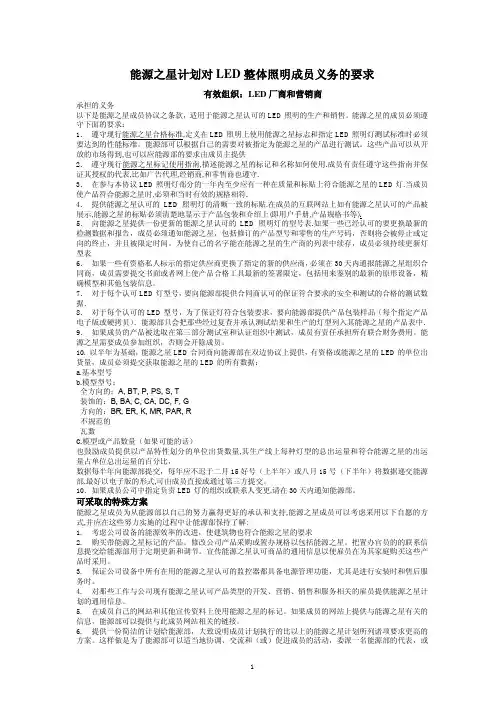
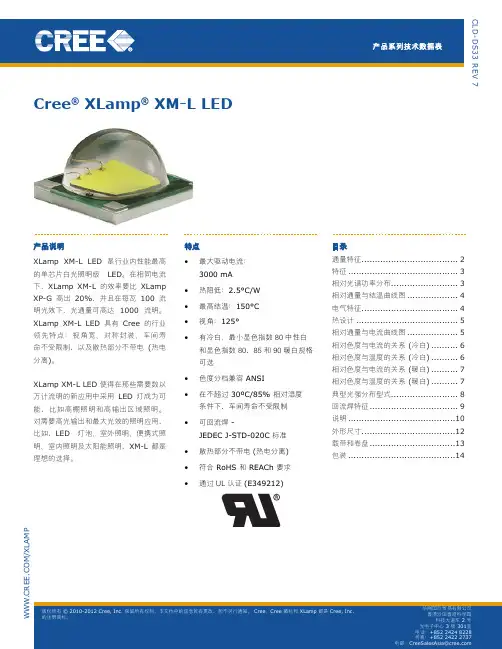
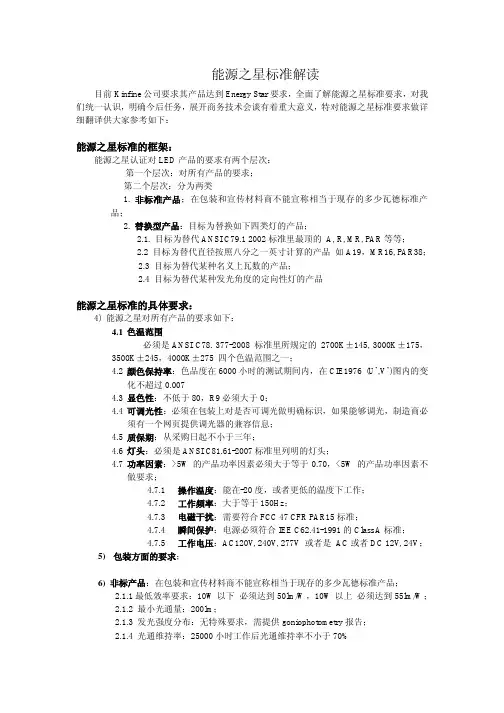
能源之星标准解读目前Kinfine公司要求其产品达到Energy Star要求,全面了解能源之星标准要求,对我们统一认识,明确今后任务,展开商务技术会谈有着重大意义,特对能源之星标准要求做详细翻译供大家参考如下:能源之星标准的框架:能源之星认证对LED产品的要求有两个层次:第一个层次:对所有产品的要求;第二个层次:分为两类1. 非标准产品;在包装和宣传材料商不能宣称相当于现存的多少瓦德标准产品;2. 替换型产品:目标为替换如下四类灯的产品;2.1. 目标为替代ANSI C79.1 2002标准里最顶的A, R, MR, PAR等等;2.2 目标为替代直径按照八分之一英寸计算的产品如A19,MR16, PAR38;2.3 目标为替代某种名义上瓦数的产品;2.4 目标为替代某种发光角度的定向性灯的产品能源之星标准的具体要求:4) 能源之星对所有产品的要求如下:4.1色温范围必须是ANSI C78. 377-2008 标准里所规定的2700K±145, 3000K±175,3500K±245,4000K±275 四个色温范围之一;4.2颜色保持率:色品度在6000小时的测试期间内,在CIE1976 (U’,V’)图内的变化不超过0.0074.3显色性:不低于80,R9必须大于0;4.4可调光性:必须在包装上对是否可调光做明确标识,如果能够调光,制造商必须有一个网页提供调光器的兼容信息;4.5质保期:从采购日起不小于三年;4.6灯头:必须是ANSI C81.61-2007标准里列明的灯头;4.7功率因素:>5W的产品功率因素必须大于等于0.70,<5W的产品功率因素不做要求;4.7.1操作温度:能在-20度,或者更低的温度下工作;4.7.2工作频率:大于等于150Hz;4.7.3电磁干扰:需要符合FCC 47 CFR PAR15标准;4.7.4瞬间保护:电源必须符合IEE C62.41-1991的Class A标准;4.7.5工作电压:AC120V, 240V, 277V 或者是AC或者DC 12V, 24V;5)包装方面的要求;6) 非标产品:在包装和宣传材料商不能宣称相当于现存的多少瓦德标准产品;2.1.1最低效率要求:10W以下必须达到50lm/W,10W以上必须达到55lm/W;2.1.2 最小光通量:200lm;2.1.3 发光强度分布:无特殊要求,需提供goniophotometry报告;2.1.4 光通维持率:25000小时工作后光通维持率不小于70%2.1.5 快速循环压力测试:参照ANSI C78.5 LM-65-01 2, 3, 5, 6条款7) 替代产品:替代产品的要求分为如下三种7A) 全方位灯包括ANSI C79 1-2002标准里的A, BT, P, PS, S, T型产品,要求如下:7A.1 最低效率要求:10W以下必须达到50lm/W,10W以上必须达到55lm/W;7A.2 最小光通量:替换20W 不小于200lm;替换35W 不小于325lm;替换40W 不小于450lm;替换60W 不小于800lm;替换75W 不小于1100lm;替换100W 不小于1600lm;7A.3发光强度分布:参考LM-79-08标准的Section10,产品必须有均匀的光分布,在0~135度内,任何角度的光强与平均光强的差别不能超过20%,至少有5%的光通量分布在135~180度角内等等要求;7A.4 产品最大直径:不超过ANSI C78.20-2003所规定的最大直径;7A.5 产品最大长度:不超过ANSI C78.20-2003所规定的最大直径;7A.6 光通维持率:25000小时工作后光通维持率不小于70%,参考LM-79-08;7A.7 快速循环压力测试:参照ANSI C78.5 LM-65-01 2, 3, 5, 6条款7B)装饰性灯包括ANSI C79 1-2002标准里的B, BA, C, CA, DC, F, G型产品,要求如下:7B.1 最低效率要求:40lm/W;7B.2 最小光通量:替换10W 不小于70lm;替换15W 不小于90lm;替换25W 不小于150lm;替换40W 不小于300lm;替换60W 不小于500lm;7B.3 产品最大直径:不超过ANSI C78.20-2003所规定的最大直径;7B.4 光通维持率:15000小时工作后光通维持率不小于70%,参考LM-79-08;7B.5 快速循环压力测试:参照ANSI C78.5 LM-65-01 2, 3, 5, 6条款7C) 定向性灯包括ANSI C79 1-2002标准里的BR, ER, K MR, PAR, R 等产品,要求如下:7C.1 定向性灯的定义是指80%的光集中在某一个角度内的产品;7C.2 最低效率要求:产品直径在20/8 英寸以上的必须达到40lm/W,产品直径在20/8 英寸以上的必须达到45lm/W,7C.3 颜色保持率:色品度在6000小时的测试期间内,在CIE1976 (U’,V’) 图内的变化不超过0.0077C.4 产品最大直径:不超过ANSI C78.20-2003所规定的最大直径;7C.5 产品最大长度:不超过ANSI C78.20-2003所规定的最大直径;7C.6 最小光输出:等于被替代灯所消耗瓦数*10;7C.7 PAR灯和MR16灯的中心光强要求:能源之星给出了一个网站,上面可以计算要求的最小中心光强;PAR灯:/htmlemail/energystar/dec09/eslntlampcenterbeamtool.zip MR16灯:/htmlemail/energystar/dec09/eslntlampcenterbeamtool.zip 7C.8 光通维持率:25000小时工作后光通维持率不小于70%,参考LM-79-08;7C.9 快速循环压力测试:参照ANSI C78.5 LM-65-01 2, 3, 5, 6条款能源之星关于光通维持率的要求如下:整灯测试6000小时,根据对应的光衰做寿命声明6000小时光通维持率允许-3%公差允许宣称的寿命装饰性灯最低要求86.70% 15000装饰性灯附加标准89.90% 20000非标准灯,全方向型灯最低要求,以及定向型,装饰型灯的选择性标准91.80% 2500093.1%% 3000094.1%% 3500094.8%% 4000095.4%% 45000所有类型灯选择性标准95.8%% 50000如果要宣称更长的寿命时间,按照以下标准:要求的最少测试时间测试完成后要求达到的最低光通维持率允许-3%公差允许宣称的寿命7500 91.20% 300008750 91.50% 3500010000 91.50% 4000012500 91.80% 45000 测试温度:非标准灯以及全方位型灯:10W以下的,测试温度为25度;非标准灯以及全方位型灯:10W以上的,测试温度为45度;装饰类的灯:25度;曾波2011-3-2。
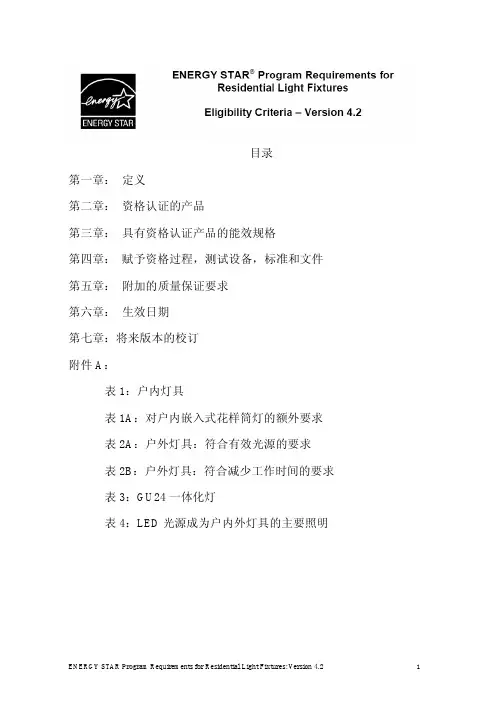
目录第一章:定义第二章:资格认证的产品第三章:具有资格认证产品的能效规格第四章:赋予资格过程,测试设备,标准和文件第五章:附加的质量保证要求第六章:生效日期第七章:将来版本的校订附件A:表1:户内灯具表1A:对户内嵌入式花样筒灯的额外要求表2A:户外灯具:符合有效光源的要求表2B:户外灯具:符合减少工作时间的要求表3:GU24一体化灯表4:LED光源成为户内外灯具的主要照明下面是住宅灯具和替换GU-24一体式灯的能源之星生产规格(4.2版)。
如果制造商想在一种产品上贴能源之星的标贴就必须符合相应的标准。
住宅灯具能源之星的目的是让消费者从传统理念上的白炽灯具转变为高质量的荧光灯具或其他的能效技术,包括针对户外灯具的运动传感器和日光传感器。
1)定义:下面是灯具和其他能源之星相关术语的简要定义:A. ALA:美国照明学会B. ANSI:美国国家标准学会C. APLAC:亚太地区试验室鉴定协会(NALAP MRA签署)。
D.自动日光关闭:一种能在白天自动禁止灯具开关开启的光电装置。
E.镇流器:一种与电子射灯一起使用的装置,用以获得开启和运做时电路的一些基本参数(电压,电流和波形)。
F.镇流器的频率:镇流器使灯泡运做时产生的频率,单位是赫兹(HZ)或千赫兹(KHZ)。
G. CIE:德国国际电工委员会。
H.显色:灯发出的光其光谱特性会使被照射的物体表面呈现一种颜色,叫做显色。
显色指数可用0~100等级表示。
显色指数是有物体在测试光照下的三色光谱值与在参照或标准光照下的三色光谱值相比较而决定的。
检索条目和标准可参照CIE公布的13.3号文件。
I.紧凑型荧光灯:一种附带插座式灯座的单灯座节能荧光灯,包括有多管型,U字型,螺旋型和环形灯管这几个种类。
J.相关色温(CCT):灯的实际颜色叫色温,是由三色光谱值(颜色坐标系)参照IESNA LM-16标准所决定的。
对于颜色坐标系中靠近黑色的地方使用相关色温,用开氏温标(K)表示。
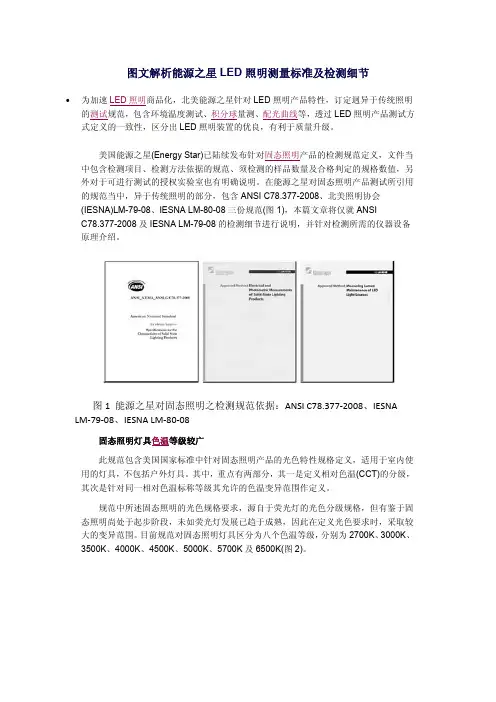
图文解析能源之星LED照明测量标准及检测细节•为加速LED照明商品化,北美能源之星针对LED照明产品特性,订定迥异于传统照明的测试规范,包含环境温度测试、积分球量测、配光曲线等,透过LED照明产品测试方式定义的一致性,区分出LED照明装置的优良,有利于质量升级。
美国能源之星(Energy Star)已陆续发布针对固态照明产品的检测规范定义,文件当中包含检测项目、检测方法依据的规范、须检测的样品数量及合格判定的规格数值,另外对于可进行测试的授权实验室也有明确说明。
在能源之星对固态照明产品测试所引用的规范当中,异于传统照明的部分,包含ANSI C78.377-2008、北美照明协会(IESNA)LM-79-08、IESNA LM-80-08三份规范(图1),本篇文章将仅就ANSIC78.377-2008及IESNA LM-79-08的检测细节进行说明,并针对检测所需的仪器设备原理介绍。
图1 能源之星对固态照明之检测规范依据:ANSI C78.377‐2008、IESNA LM‐79‐08、IESNA LM‐80‐08固态照明灯具色温等级较广此规范包含美国国家标准中针对固态照明产品的光色特性规格定义,适用于室内使用的灯具,不包括户外灯具。
其中,重点有两部分,其一是定义相对色温(CCT)的分级,其次是针对同一相对色温标称等级其允许的色温变异范围作定义。
规范中所述固态照明的光色规格要求,源自于荧光灯的光色分级规格,但有鉴于固态照明尚处于起步阶段,未如荧光灯发展已趋于成熟,因此在定义光色要求时,采取较大的变异范围。
目前规范对固态照明灯具区分为八个色温等级,分别为2700K、3000K、3500K、4000K、4500K、5000K、5700K及6500K(图2)。
图2 八个相对色温指定值在CIE 1931之区域定义图2中六个椭圆区块为ANSI C78.376定义荧光灯的色温等级区块,其所采取的色温允许变异范围为七阶Mac Adam椭圆范围。
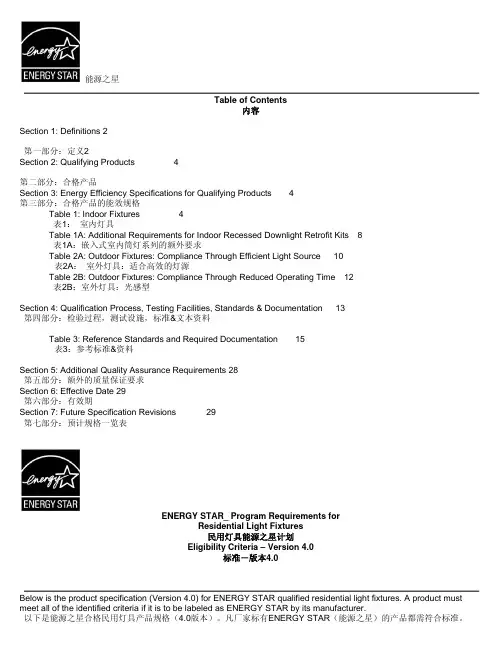
能源之星Table of Contents内容Section 1: Definitions 2第一部分:定义2Section 2: Qualifying Products 4第二部分:合格产品Section 3: Energy Efficiency Specifications for Qualifying Products 4第三部分:合格产品的能效规格Table 1: Indoor Fixtures 4表1:室内灯具Table 1A: Additional Requirements for Indoor Recessed Downlight Retrofit Kits 8表1A:嵌入式室内筒灯系列的额外要求Table 2A: Outdoor Fixtures: Compliance Through Efficient Light Source 10表2A:室外灯具:适合高效的灯源Table 2B: Outdoor Fixtures: Compliance Through Reduced Operating Time 12表2B:室外灯具:光感型Section 4: Qualification Process, Testing Facilities, Standards & Documentation 13第四部分:检验过程,测试设施,标准&文本资料Table 3: Reference Standards and Required Documentation 15表3:参考标准&资料Section 5: Additional Quality Assurance Requirements 28第五部分:额外的质量保证要求Section 6: Effective Date 29第六部分:有效期Section 7: Future Specification Revisions 29第七部分:预计规格一览表ENERGY STAR_ Program Requirements forResidential Light Fixtures民用灯具能源之星计划Eligibility Criteria – Version 4.0标准-版本4.0Below is the product specification (Version 4.0) for ENERGY STAR qualified residential light fixtures. A product must meet all of the identified criteria if it is to be labeled as ENERGY STAR by its manufacturer.以下是能源之星合格民用灯具产品规格(4.0版本)。
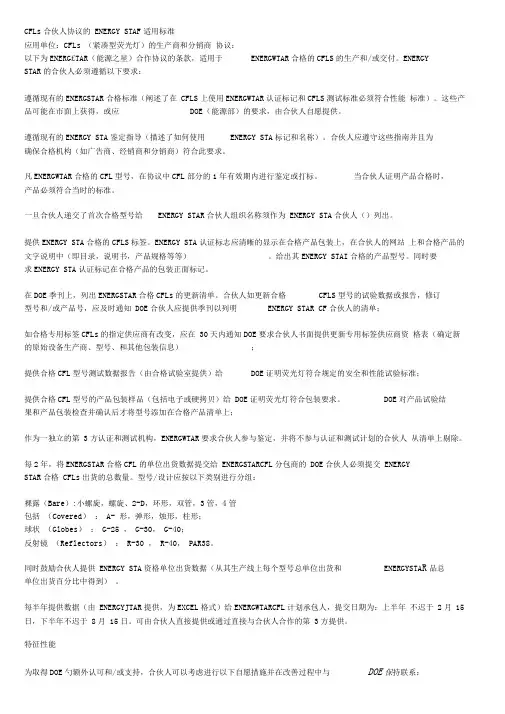
CFLs合伙人协议的ENERGY STAF适用标准应用单位:CFLs (紧凑型荧光灯)的生产商和分销商协议:以下为ENERG£TAR(能源之星)合作协议的条款,适用于ENERGWTAR合格的CFLS的生产和/或交付。
ENERGYSTAR的合伙人必须遵循以下要求:遵循现有的ENERGSTAR合格标准(阐述了在CFLS上使用ENERGWTAR认证标记和CFLS测试标准必须符合性能标准)。
这些产品可能在市面上获得,或应DOE(能源部)的要求,由合伙人自愿提供。
遵循现有的ENERGY STA鉴定指导(描述了如何使用ENERGY STA标记和名称)。
合伙人应遵守这些指南并且为确保合格机构(如广告商、经销商和分销商)符合此要求。
凡ENERGWTAR合格的CFL型号,在协议中CFL部分的1年有效期内进行鉴定或打标。
当合伙人证明产品合格时,产品必须符合当时的标准。
一旦合伙人递交了首次合格型号给ENERGY STAR合伙人组织名称须作为ENERGY STA合伙人()列出。
提供ENERGY STA合格的CFLS标签。
ENERGY STA认证标志应清晰的显示在合格产品包装上,在合伙人的网站上和合格产品的文字说明中(即目录,说明书,产品规格等等)。
给出其ENERGY STAI合格的产品型号。
同时要求ENERGY STA认证标记在合格产品的包装正面标记。
在DOE季刊上,列出ENERGSTAR合格CFLs的更新清单。
合伙人如更新合格CFLS型号的试验数据或报告,修订型号和/或产品号,应及时通知DOE合伙人应提供季刊以列明ENERGY STAR CF合伙人的清单;如合格专用标签CFLs的指定供应商有改变,应在30天内通知DOE要求合伙人书面提供更新专用标签供应商资格表(确定新的原始设备生产商、型号、和其他包装信息);提供合格CFL型号测试数据报告(由合格试验室提供)给DOE证明荧光灯符合规定的安全和性能试验标准;提供合格CFL型号的产品包装样品(包括电子或硬拷贝)给DOE证明荧光灯符合包装要求。
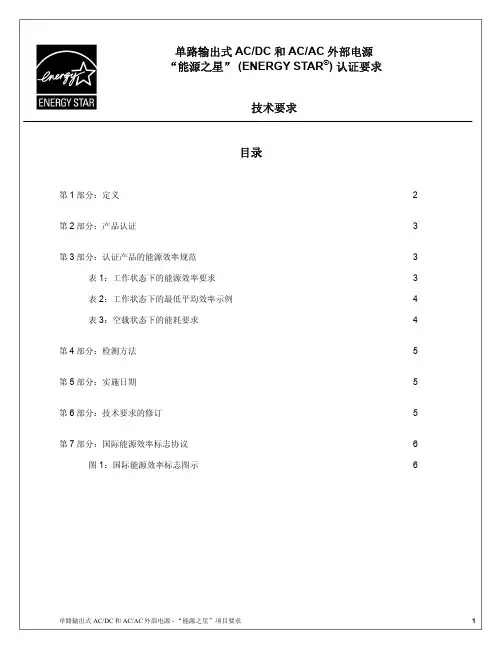
第1 部分:定义以下是符合“能源之星”标准的单路输出式造商生产的外部电源产品,只有符合所有这些标准,才能取得“能源之星”认证。
1) 定义: “能源之星”外部电源产品规范的目的是用来鉴别具有高效源型号。
针对这一目的以及本文第四部分所述的检测方法,美国环保局已对单路输出式AC/ACB. 单路输出式AC/AC 外部电源:本规范所指的单路输出式AC/AC 外部电源应当是:a) 把交流电网电压转换为交流低电压;b) 每次使用时只提供一个固定的交流电压输出;c) 与用电负载配套;d) 可与用电负载分离;e) 通过电线、电缆或其他永久性连线与终端产品相连接;f) 不配备任何电池;g) 不带有化学电池,不带选择开关和指示灯,不带有充电状态指示器。
(例如,带有类型选择开关和充电状态显示器的产品就不适用本技术要求,而只有一个指示灯的电源仍适用本要求)h) 标称输出功率小于或等于250W。
C. 工作状态:电源输入端连接到电网上,输出端连接到负载上,负载功率在电源的标称值和零之间。
D. 空载状态:电源输入端连接到了电网上,而输出端不连接负载。
2) 产品认证:若要获得“能源之星”认证,外部电源型号必须符合第1 部分1.A 或1.B 中的定义,以及下面第3 部分中的规范要求。
3) 认证产品的能源效率要求:只有当第2 部分中所述产品在工作状态和空载状态下能够同时满足下列要求时,才能取得“能源之星”认证。
A. 工作状态1. 阶段1:若想取得“能源之星”认证,外部电源产品型号必须达到或者超过“能源之星”工作状态最低平均效率要求。
该最低平均效率根据产品标称功率的不同划分。
表1 列出了确定最低平效率的计算公式,式中P no 代表标称输出功率,Ln 代表自然对数。
效率应采用小数表示,然后转化为百分比。
表1: 工作状态下的能源利用效率标准标称输出功率 (P no) 工作状态下的最低平均效率(用小数表示)10 <Pno ≤1 W ≥ 0.49 * P no1<Pno ≤49 W ≥ [0.09 * Ln (P no)] + 0.49Pno >49 W ≥ 0.84工作状态分析示例:工作状态下的平均能源效率以及能否取得“能源之星”认证,由以下因素决定:• 根据“检测方法”,在输出电流分别为额定电流的100%、75%、50%和25%时进行测试,然后计算出这四个数值的算术平均值,即可计算被测型号产品在工作状态下的单机平均运行效率值。
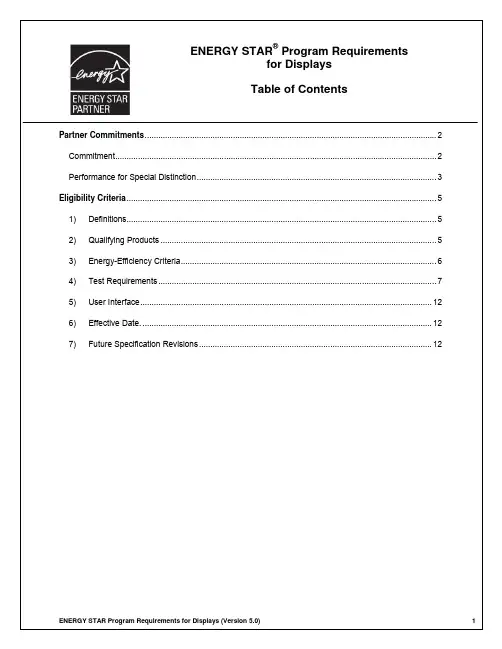
• include information on the importance of power management in either the product manual or as a box insert for displays intended for use with computers. This information should include areference to the energy saving and environmental benefits of power management for both thedisplay and computer. In addition, where a display is packaged for sale with a computer, a linkshould be made available to /powermanagement from the display and/orcomputer product pages, product specifications, and related content pages. At the Partner’srequest, EPA will supply suggested facts and figures related to the above criteria, templateelements, or a complete template suitable for use in user guides or box inserts;• provide to EPA, on at least an annual basis, an updated list of ENERGY STAR qualified display models. Once the Partner submits its first list of ENERGY STAR qualified display models, thePartner will be listed as an ENERGY STAR Partner. Partner must provide an update at leastannually in order to remain on the list of participating product Partners. Listing products via theOnline Product Submittal OPS tool satisfies the annual update requirement;• provide to EPA, on an annual basis, unit shipment data or other market indicators to assist in determining the market penetration of ENERGY STAR. Specifically, Partner must submit the total number of ENERGY STAR qualified displays shipped (in units by model) or an equivalentmeasurement as agreed to in advance by EPA and Partner. Partner is also encouraged to provide ENERGY STAR qualified unit shipment data segmented by meaningful product characteristics(e.g., screen size, resolution, or other as relevant), total unit shipments for each model in itsproduct line, and percent of total unit shipments that qualify as ENERGY STAR. The data for each calendar year should be submitted to EPA, preferably in electronic format, no later than thefollowing March and may be provided directly from the Partner or through a third party. The data will be used by EPA only for program evaluation purposes and will be closely controlled. Ifrequested under the Freedom of Information Act (FOIA), EPA will argue that the data is exempt.Any information used will be masked by EPA so as to protect the confidentiality of the Partner; • notify EPA of a change in the designated responsible party or contacts for displays within 30 days.Performance for Special DistinctionIn order to receive additional recognition and/or support from EPA for its efforts within the Partnership, the ENERGY STAR Partner may consider the following voluntary measures and should keep EPA informed on the progress of these efforts:• consider energy efficiency improvements in company facilities and pursue the ENERGY STAR label for buildings;• purchase ENERGY STAR qualified products. Revise the company purchasing or procurement specifications to include ENERGY STAR. Provide procurement officials’ contact information toEPA for periodic updates and coordination. Circulate general ENERGY STAR qualified productinformation to employees for use when purchasing products for their homes;• ensure the power management feature is enabled on all ENERGY STAR qualified displays in use in company facilities, particularly upon installation and after service is performed;• provide general information about the ENERGY STAR program to employees whose jobs are relevant to the development, marketing, sales, and service of current ENERGY STAR qualifiedproduct models;• feature the ENERGY STAR mark on Partner Web site and in other promotional materials. If information concerning ENERGY STAR is provided on the Partner Web site as specified by theENERGY STAR Web Linking Policy (this document can be found in the Partner Resourcessection on the ENERGY STAR Web site at ), EPA may provide links whereappropriate to the Partner Web site;• provide a simple plan to EPA outlining specific measures Partner plans to undertake beyond the program requirements listed above. By doing so, EPA may be able to coordinate, communicate, and/or promote Partner’s activities, provide an EPA representative, or include news about theevent in the ENERGY STAR newsletter, on the ENERGY STAR Web pages, etc. The plan maybe as simple as providing a list of planned activities or planned milestones that Partner would like EPA to be aware of. For example, activities may include: (1) increase the availability of ENERGY STAR qualified products by converting the entire product line within two years to meet ENERGY STAR guidelines; (2) demonstrate the economic and environmental benefits of energy efficiency through special in-store displays twice a year; (3) provide information to users (via the Web siteand user’s manual) about energy-saving features and operating characteristics of ENERGY STAR qualified products, and (4) build awareness of the ENERGY STAR Partnership and brand identity by collaborating with EPA on one print advertorial and one live press event;• provide quarterly, written updates to EPA as to the efforts undertaken by Partner to increase availability of ENERGY STAR qualified products, and to promote awareness of ENERGY STAR and its message;• join EPA's SmartWay Transport Partnership to improve the environmental performance of the company's shipping operations. SmartWay Transport works with freight carriers, shippers, andother stakeholders in the goods movement industry to reduce fuel consumption, greenhousegases, and air pollution. For more information on SmartWay, visit /smartway;• join EPA's Climate Leaders Partnership to inventory and reduce greenhouse gas emissions.Through participation, companies create a credible record of their accomplishments and receive EPA recognition as corporate environmental leaders. For more information on Climate Leaders,visit /climateleaders;• join EPA’s Green Power partnership. EPA's Green Power Partnership encourages organizations to buy green power as a way to reduce the environmental impacts associated with traditional fossil fuel-based electricity use. The partnership includes a diverse set of organizations includingFortune 500 companies, small and medium businesses, government institutions as well as agrowing number of colleges and universities, visit /grnpower.1) Definitions: Below is a brief description of an Electronic Display and other terms as relevant toC. Television Tuners: If the display has an integrated television tuner, it may qualify for ENERGYSTAR under this specification as long as it is primarily marketed and sold to consumers as adisplay or as a dual-function display and television. Any display with a television tuner that ismarketed and sold exclusively as a television is not eligible to qualify under this specification.Under Tier 2 of this specification, only those displays without tuners may qualify; displays withtuners may qualify under Tier 2 of the Version 3.0 ENERGY STAR TV specification.D. Automatic Brightness Control (ABC): To qualify for ENERGY STAR using the AutomaticBrightness Control On Mode power equation, the display must ship with ABC enabled by default.E. External Power Supply: If the display is shipped with an EPS, the EPS must be ENERGY STARqualified or meet the no-load and active mode efficiency levels provided in the ENERGY STARProgram Requirements for Single Voltage AC-AC and AC-DC External Power Supplies. TheENERGY STAR specification and qualified product list can be found at/powersupplies.F. Power Management Requirements: The display must have at least one mechanism enabled bydefault that allows the display to automatically enter Sleep or Off Mode. For instance, data ornetwork connections must support powering down the display according to standard mechanisms, such as Display Power Management Signaling. Displays generating their own content must havea sensor or timer enabled by default to automatically engage Sleep or Off Mode.3) Energy-Efficiency Criteria:A. On Mode Requirements:1. Tier 1: To qualify as ENERGY STAR, the display must not exceed the maximum On Modepower consumption (P O or P O1) as calculated from the equations below. The maximum OnMode power consumption is expressed in watts and rounded to the nearest tenth of a watt.Table 1. Tier 1 On Mode Power Consumption RequirementsDisplay CategoryMaximum On Mode Power Consumption (W)Diagonal Screen Size < 30 inchesScreen Resolution ≤ 1.1 MPP O = 6*(MP) + 0.05*(A) + 3 Diagonal Screen Size < 30 inchesScreen Resolution > 1.1 MPP O = 9*(MP) + 0.05*(A) + 3 Diagonal Screen Size 30 - 60 inchesAll Screen ResolutionsP O = 0.27*(A) + 8MP = Display Resolution (megapixels)A = Viewable Screen Area (square inches)EXAMPLE: The maximum On Mode power consumption for a display with 1440 x 900 resolution, or 1,296,000 pixels, a 19 inch viewable diagonal screen size and a viewable screen area of 162 square inches, would be: ((9 x 1.296) + (0.05 x 162)) + 3 = 22.8 watts when rounded to the nearest tenth of a watt.Table 2. Sample Tier 1 On Mode Maximum Power Consumption Requirements1 DiagonalScreen Size (inches) Resolution MegapixelsScreenDimensions(inches)ScreenArea(sq. in.)Maximum OnMode PowerConsumption(watts)7 800 x 480 0.384 5.9 x 3.5 21 6.419 1440 x 900 1.296 16.07 x 10.05 162 22.826 1920 x 1200 2.304 21.7 x 13.5 293 38.442 1360 x 768 1.044 36 x 20 720 202.450 1920 x 1080 2.074 44 x 24 1056 293.11 For displays between 30 and 60 inches, resolution must be reported when submitting a product for qualification; however, resolution is not considered when calculating the On Mode power consumption of these displays.2. Tier 2: To qualify as ENERGY STAR, the display must not exceed the following maximum OnMode consumption equations: TBD.3. Displays with Automatic Brightness Control: EPA has noted a substantial increase in thedefault luminance settings of displays since the last revision of this specification. Based on theEPA data set, there is a strong positive relationship between luminance and On Mode powerconsumption. While EPA recognizes the benefits of offering consumers full-featured products,higher luminance settings tend to negate the power consumption reductions achieved throughimproved component efficiency. Automatic Brightness Control (ABC) technology can offsetthe effects of these higher default settings by automatically modulating the luminance ofdisplays under variable ambient lighting conditions. In addition to offering significant energysavings, this feature can also improve the user viewing experience. As with the most recentrevision of the ENERGY STAR TV specification, EPA rewards products that ship with ABCfeatures enabled by default.An alternate calculation is used to calculate maximum On Mode power consumption fordisplays shipped with ABC enabled by default:P O1 = (0.8 * P h) + (0.2 * P l)where P O1 is the average On Mode power consumption in watts, rounded to the nearest tenthof a watt, P h is the On Mode power consumption in high ambient lighting conditions, and P l isthe On Mode power consumption in low ambient lighting conditions. The formula assumes thedisplay will be in low ambient lighting conditions 20% of the time.B. Sleep and Off Mode Requirements:1. Tiers 1 and 2: To qualify as ENERGY STAR, the display must not exceed the maximumpower consumption levels for Sleep and Off Modes provided in Table 3, below. Displayscapable of multiple Sleep Modes (i.e., Sleep and Deep Sleep) must meet Sleep Moderequirements in all sleep modes.EXAMPLE: A display test result of 3 watts in Sleep and 2 watts in Deep Sleep would notqualify because power consumption in one of the Sleep Modes exceeded the 2 watt Tier 1limit.Table 3. Sleep and Off Mode Power Consumption Requirements for all DisplaysMode Tier 1 Tier 2 Maximum Sleep Mode Power Consumption (W) ≤ 2 ≤ 1Maximum Off Mode Power Consumption (W) ≤ 1 ≤ 14) Test RequirementsHow to Use this SectionEPA utilizes, where possible, widely-accepted industry practices for measuring product performance and power consumption under typical operating conditions. The test methods in this specification are based on standards from the Video Electronics Standards Association (VESA) Display Metrology Committee and the International Electrotechnical Commission (IEC). In cases where the VESA and IEC standards were insufficient for the needs of the ENERGY STAR program, additional testing and measurement methods were developed in cooperation with industry stakeholders.To ensure a consistent means for measuring the power consumption of electronics products such that the test results may be reproduced, and that outside factors do not adversely affect the test results, the following protocol must be followed. It has four main components:Test Conditions and InstrumentationSetupTest MethodDocumentationNote: Test Method is located in Annexes 1 and 2. Annex 1 describes the test procedure fordisplays with a viewable diagonal screen size measuring less than (<) 30 inches. Annex 2describes the test procedure for displays with a viewable diagonal screen size measuring from 30 to 60 inches, inclusive.Partners may elect to use an in-house or independent laboratory to provide the test results.Facility Quality ControlPartners are required to perform tests and certify those product models that meet the ENERGY STAR guidelines. In order to conduct testing in support of qualification for ENERGY STAR, the product must be tested in a facility that has quality control procedures for monitoring the validity of tests and calibrations. ENERGY STAR recommends conducting these tests in a facility that follows the general requirements for the competence of testing and calibration laboratories as described in the International Standard ISO/IEC 17025.Test Conditions and InstrumentationA. Power Measurement Protocols: The average true power consumption of the display shall bemeasured during On Mode, Sleep Mode, and Off Mode. When performing measurements to self-certify a product model, the Unit Under Test (UUT) must initially be in the same condition (e.g., configuration and settings) as when shipped to the customer, unless adjustments need to be made pursuant to the instructions below.1. Power measurements shall be taken from a point between the outlet or power source and theUUT.2. If a product’s electrical power comes from Mains, USB, IEEE1394, Power-over-Ethernet,telephone system, or any other means or combinations of means, the net AC electrical power consumed by the product (taking into account AC-to-DC conversion losses) must be used for qualification.3. Products powered by a standard low voltage DC supply (e.g., USB, USB PlusPower, IEEE1394, and Power Over Ethernet) shall utilize a suitable AC-powered source of the DC power.This AC-powered source’s energy consumption shall be measured and recorded as theUUT’s power consumption.4. For a display powered by USB, a powered hub serving only the display being tested shall beused. For a display powered by Power Over Ethernet or USB PlusPower, it is acceptable tomeasure the power distribution device with and without the display connected, and record the difference between the two readings as the display’s power consumption. The tester shouldconfirm that this reasonably reflects the unit’s DC consumption plus some allowance forpower supply and distribution inefficiency.5. Any product capable of being powered from both AC and standard low-voltage DC sourcesshall be tested while operating on AC power.B. Input AC Power Requirements:Supply Voltage: North America/Taiwan:Europe/Australia/NewZealand:Japan: 115 (± 1%) Volts AC, 60 Hz (± 1%)230 (± 1%) Volts AC, 50 Hz (± 1%)100 (± 1%) Volts AC, 50 Hz (± 1%)/60 Hz (± 1%) Note: For products rated for > 1.5 kW maximum power, the voltage range is ± 4%Total Harmonic Distortion (THD) (Voltage): < 2% THD (< 5% for products which are rated for > 1.5 kW maximum power)Ambient Temperature: 23°C ± 5°CRelative Humidity: 10 – 80%(Reference IEC 62301 Ed 1.0: Household Electrical Appliances – Measurement of Standby Power, Sections 4.2, 4.3)C. Approved Meter: Approved meters will include the following attributes.2An available current crest factor of 3 or more at its rated range value; andLower bound on the current range of 10mA or less.The power measurement instrument shall have a resolution of:0.01 W or better for power measurements of 10 W or less;0.1 W or better for power measurements of greater than 10 W up to 100 W; and1 W or better for power measurements of greater than 100 W.The following attributes in addition to those above are suggested:Frequency response of at least 3 kHz; andCalibration with a standard that is traceable to the U.S. National Institute of Standards and Technology (NIST).It is also desirable for instruments to be able to measure average power over any user-selectedtime interval (the most accurate devices perform an internal calculation to divide accumulatedenergy by elapsed time). As an alternative, the measurement instrument would have to becapable of integrating energy over any user-selected time interval with an energy resolution ofless than or equal to 0.1 mWh and integrating time displayed with a resolution of 1 second or less.D. Accuracy: Measurements of power of 0.5 W or greater shall be made with an uncertainty of lessthan or equal to 2% at the 95% confidence level. Measurements of power of less than 0.5 W shall be made with an uncertainty of less than or equal to 0.01 W at the 95% confidence level.3All measurements should be recorded in watts and rounded to the nearest tenth of a watt.E. Dark Room Conditions: All luminance testing shall be performed in dark room conditions. Thedisplay screen illuminance measurement (E) in Off Mode must be less than or equal to 1.0 lux.Measurements should be taken perpendicular to the center of the display screen using a LightMeasuring Device (LMD) with the display in Off Mode (Reference VESA FPDM Standard 2.0,Section 301-2F).2 Characteristics of approved meters taken from IEC 62301 Ed 1.0: Household Electrical Appliances – Measurement of Standby Power.3 Ibid.F. Light Measurement Protocols: When light measurements, such as illuminance and luminance,need to be made, an LMD shall be used with the display located in dark room conditions. The LMD shall be used to take measurements at the center of and perpendicular to the display screen (Reference VESA FPDM Standard 2.0, Appendix A115). The screen surface area to be measured shall cover at least 500 pixels, unless this exceeds the equivalent of a rectangular area with sides of length equal to 10% of the visible screen height and width (in which case this latter limitapplies). However, in no case may the illuminated area be smaller than the area the LMD ismeasuring (Reference VESA FPDM Standard 2.0, Section 301-2H).SetupA. Peripherals: No external devices shall be connected to Universal Serial Bus (USB) hubs or ports.Any built-in speakers, TV tuners, etc. may be placed in their minimum power configuration, as adjustable by the user, to minimize power consumption not associated with the display itself.B. Modifications: Device modifications such as circuit removal, or other actions not available to atypical user, are not permitted.C. Analog vs. Digital Interface: Partners are required to test their displays using the analog interface,except in those cases where one is not provided (i.e., digital interface displays, which for the purposes of this test method are defined as having only a digital interface). For digital interface displays, please see Footnote 1 in Annex 1 for voltage information, and follow the test method in Annex 1 and/or 2, depending on the viewable diagonal screen size of the UUT, using a digital signal generator.D. Models Capable of Operating at Multiple Voltage/Frequency Combinations: Partners shall test,qualify, and document conditions applicable to each market in which their products shall be sold as ENERGY STAR qualified.EXAMPLE: For a product to earn the ENERGY STAR label in both the United States and Europe, it must qualify at both 115V/60Hz and 230V/50Hz. If the product qualifies as ENERGY STAR at only one voltage/frequency combination (e.g., 115 Volts/60 Hz), then it may only be qualified and promoted as ENERGY STAR in those regions that support the tested voltage/frequencycombination (e.g., North America and Taiwan).E. External Power Supply: For displays shipped with an external power supply, the supplied EPSmust be used for all testing. An alternate power supply may not be substituted.F. C olor Controls: All color controls (hue, saturation, gamma, etc.) shall be set to factory defaultsettings.G. Resolution and Refresh Rate: Resolution and refresh rate vary by technology, as follows:1. For LCDs and other fixed pixel technologies, pixel format shall be set to the native level. LCDrefresh rate shall be set to 60 Hz, unless a different refresh rate is specifically recommended by the Partner, in which case that rate shall be used.2. CRT pixel format shall be set at the preferred pixel format with the highest resolution that isintended to be driven at a 75 Hz refresh rate. A VESA Discrete Monitor Timing (DMT) ornewer industry standard pixel format timing must be used for the test. The CRT display must be capable of meeting all its Partner-stated quality specifications in the tested format.H. Warm-up: UUT must be warmed up for a minimum of 20 minutes before any test measurementsare taken (Reference VESA FPDM Standard 2.0, Section 301-2D or 305-3 for warm-up test).I. S tability: All power consumption measurements shall be recorded after instrument readings arestable to within 1% over a three-minute period. (Reference IEC 4.3.1).5) User Interface: Partners are strongly recommended to design products in accordance with the userinterface standard IEEE P1621: Standard for User Interface Elements in Power Control of Electronic Devices Employed in Office/Consumer Environments. The Power Management Controls projectdeveloped this standard to make power controls more consistent and intuitive across all electronic devices. For details, see /Controls.6) Effective Date: The date that Partners may begin to qualify products as ENERGY STAR, under theVersion 5.0 specification, will be defined as the effective date of the agreement. Any previouslyexecuted agreement on the subject of ENERGY STAR qualified displays shall be terminated effective October 29, 2009 for displays with a viewable diagonal screen size under 30 inches, or on January 29, 2010 for displays with a viewable diagonal screen size from 30 to 60 inches, inclusive.A. Qualifying Products Under Tier 1 of the Version 5.0 Specification: The date upon which Tier 1 ofthe Version 5.0 specification shall go into effect is contingent upon the size of the display, and is outlined in the table below. All products, including models originally qualified under Version 4.1,with a date of manufacture on or after that date must meet the new Version 5.0 requirements inorder to qualify for ENERGY STAR (including additional shipments of models originally qualified under Version 4.1). The date of manufacture is specific to each unit and is the date (e.g., monthand year) of which a unit is considered to be completely assembled.Display Category Tier 1 Effective DateDiagonal Screen Size < 30 inches October 30, 2009Diagonal Screen Size 30 - 60 inches January 30, 2010B. Qualifying Products Under Tier 2 of the Version 5.0 Specification: The second phase of thisspecification, Tier 2, shall take effect on October 30, 2011, and apply to products with a date ofmanufacture on or after October 30, 2011. For example, a unit with a date of manufacture ofOctober 30, 2011 must meet the Tier 2 specification in order to qualify as ENERGY STAR.C. Elimination of Grandfathering: EPA will not allow grandfathering under this Version 5.0 ENERGYSTAR specification. ENERGY STAR qualification under Version 4.1 is not automaticallygranted for the life of the product model. Therefore, any product sold, marketed, or identifiedby the manufacturing partner as ENERGY STAR must meet the current specification in effect atthe time of manufacture of the product.7) Future Specification Revisions: EPA reserves the right to change the specification shouldtechnological and/or market changes affect its usefulness to consumers, industry, or the environment.In keeping with current policy, revisions to the specification are arrived at through stakeholderdiscussions.EPA will periodically assess the market in terms of energy efficiency and new technologies. Asalways, stakeholders will have an opportunity to share their data, submit proposals, and voice any concerns. EPA will strive to ensure that the Tier 1 and 2 specifications recognize the most energy-efficient models in the marketplace and reward those Partners who have made efforts to furtherimprove energy efficiency.Greenhouse Gas EmissionsEPA is interested in working with LCD industry stakeholders through the ENERGY STAR program to reduce the emission of high global warming potential gases associated with LCD production,specifically NF3, SF6, and CF4. This area of concern presents an opportunity to significantly reduce emissions beyond product use-phase and to engage our partners in achieving significant, measurable greenhouse gas and energy reductions from the other phases of the product lifecycle.Harmonization of DisplaysEPA is committed to continuing to develop performance levels for displays and televisions in a similar and convergent manner, as reflected in industry and market trends. Under Tier 2, EPA will explore testing all displays for On Mode power consumption using the IEC 62087 test procedure. Issues such as luminance boundary levels, mode requirements, test conditions, power saving features, and other energy related attributes will be explored with stakeholders during the Tier 2 specificationdevelopment process.。
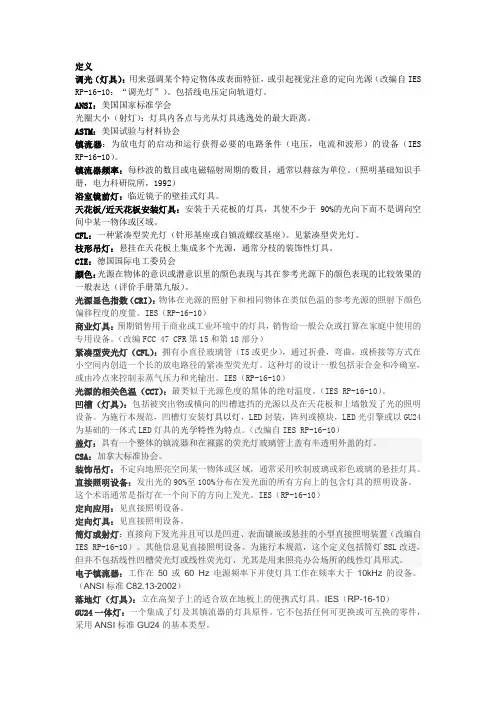
定义调光(灯具):用来强调某个特定物体或表面特征,或引起视觉注意的定向光源(改编自IES RP-16-10:“调光灯”)。
包括线电压定向轨道灯。
ANSI:美国国家标准学会光圈大小(射灯):灯具内各点与光从灯具逃逸处的最大距离。
ASTM:美国试验与材料协会镇流器:为放电灯的启动和运行获得必要的电路条件(电压,电流和波形)的设备(IES RP-16-10)。
镇流器频率:每秒波的数目或电磁辐射周期的数目,通常以赫兹为单位。
(照明基础知识手册,电力科研院所,1992)浴室镜前灯:临近镜子的壁挂式灯具。
天花板/近天花板安装灯具:安装于天花板的灯具,其使不少于90%的光向下而不是调向空间中某一物体或区域。
CFL:一种紧凑型荧光灯(针形基座或自镇流螺纹基座)。
见紧凑型荧光灯。
枝形吊灯:悬挂在天花板上集成多个光源,通常分枝的装饰性灯具。
CIE:德国国际电工委员会颜色:光源在物体的意识或潜意识里的颜色表现与其在参考光源下的颜色表现的比较效果的一般表达(评价手册第九版)。
光源显色指数(CRI):物体在光源的照射下和相同物体在类似色温的参考光源的照射下颜色偏移程度的度量。
IES(RP-16-10)商业灯具:预期销售用于商业或工业环境中的灯具,销售给一般公众或打算在家庭中使用的专用设备。
(改编FCC 47 CFR第15和第18部分)紧凑型荧光灯(CFL):拥有小直径玻璃管(T5或更少),通过折叠,弯曲,或桥接等方式在小空间内创造一个长的放电路径的紧凑型荧光灯。
这种灯的设计一般包括汞合金和冷确室,或由冷点来控制汞蒸气压力和光输出。
IES(RP-16-10)光源的相关色温(CCT):最类似于光源色度的黑体的绝对温度。
(IES RP-16-10)。
凹槽(灯具):包括被突出物或横向的凹槽遮挡的光源以及在天花板和上墙散发了光的照明设备。
为施行本规范,凹槽灯安装灯具以灯,LED封装,阵列或模块,LED光引擎或以GU24为基础的一体式LED灯具的光学特性为特点。
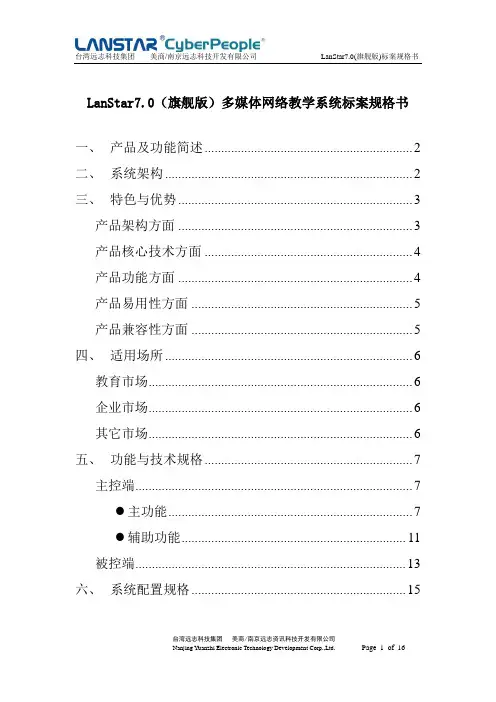
能源之星标准系列分析解读一、LM79LM79定了SSL产品的总光通量、电功率、光强分布、色参数、色均匀性等参数的测试方法。
本标准包括LED的SSL产品以及整体式LED灯(要求仅用交流或直流驱动)。
本标准不含盖要求有外部驱动电路或外部热沉的SSL产品(LED芯片,LED封装和LED 模块等)。
大体来讲测试可分为积分球测试和分布光度计测试:积分球测试:电压、电流、功率、色温、显色指数、光谱分布分布光度计测试:电压、电流、功率、总光通量、光强分布、色均匀性对LM79而言积分球测试不测光通量,否则需要辅助灯等十分复杂的步骤。
二、LM80LM80是指对光源的测量,“光源”仅指封装、阵列和模块。
其要点如下:a、老化过程与测试过程分开,老化过程要严格控制Tc点的温度为55度、85度或供应商指定的温度。
老化到规定的测试间隔后恢复到测试环境进行光度测试。
b、要求对光通量和色参数进行测试,具体的测试方法并没有严格规定。
c、对环境控制、Tc的温度控制、供电设备有较高的要求。
d、对样品和老化过程的追踪和记录有详细的要求。
三、LM82LM82是LM79的后续标准,他规定了升高温度后的LED光引擎和整体式LED灯在不同温度下的电气和光学测试。
主要有以下重点:a、待测样品需要给出温度监控点Tb以及电源的温度监控点Td(不强制)。
b、初始测试—按照LM79第九节在环境温度为25±1℃进行功率、光通量及色参数。
的测试,并监控此时的Tb值,记为Tbic、校准测试—通过调节环境温度使得Tb到初始测试时的环境温度(25±1℃),然后进行功率、光通量及色参数的测试,并监控记录此时的Tb值,记为Tb。
d、第一次温升测试—通过调节环境温度使Tb到达Tb0+25℃,然后进行功率、光通量及色参数的测试,并监控记录此时的Tb值,记为Tb。
1e、第二次温升测试—通过调节环境温度使Tb到达Tb+50℃,然后进行功率、光通量及色参数的测试,并监控记录此时的Tb值,记为Tb。
致力創新追求卓越Digital Power Meter 66200 Series 能源之星介紹-電腦/EPS/IPS產品協理: 周晏加何謂ENERGY STAR 能源之星1.西元1992年, 美國環境保護局( Environmental Protection AgencyEPA) 首度提出.2. 開始只有規範computer和monitor, 逐漸擴展至office equipment,lighting, home electronics, and more. 每年增加, 現在已經超出40種類的產品.•不僅是一個法規, 是個對節省民生能源的計畫, 教育民眾購買有ENERGY STAR標籤的產品, 對廠商則造成壓力.4. 最新版(第四版)能源之星對電腦之要求, 對其電源供應器及各狀態操作下所消耗功率都有明確的定義及要求. 要求實施日期為2007年7月20日.ENERGY STAR 標籤電腦系統測試1. 待機Standby ( Off Mode )測試:使UUT 關機以處於待機狀態,設定電表開始以每秒一個讀數之間隔累積真實用電量數值五分鐘。
紀錄這五分鐘期間測量得之平均(算術平均)數值。
2. 怠機模式( Idle Mode )測試:將電腦開啟,開始紀錄經歷時間。
開始時間為電腦開關開啟時,或是在完成系統開啟所需之登入活動的即刻。
在作業系統完全上載與完成啟動並且登入後,關閉任何開啟視窗,使螢幕上呈現一個標準作業桌面或是等同之完成作業準備螢幕。
在初始啟動(initial boot)或是登入之後剛好15 分鐘時,設定電表開始以每秒一個讀數之間隔累積真實用電量數值五分鐘。
紀錄這五分鐘期間測量得之平均(算術平均)數值。
電腦系統測試3. 睡眠模式( Sleep Mode )測試:在完成怠機狀態測量之後,使電腦進入睡眠模式。
若有必要時重置(reset)電表並開始以每秒一個讀數之間隔累積真實用電量數值達五分鐘。
紀錄這五分鐘期間測量得之平均(算術平均)數值。
美国能源之星整体式LED 灯认证要求最终版公布灯认证要求最终版公布,,预计2010年8月生效2009年12月3日,能源之星发布了《整体式LED 灯能源之星认证》Final 版。
在继2009年1月、5月及9月分别发布了三个草案后,能源之星终于提出了整体式LED 灯认证标准的确认版。
该标准预计从2010年8月31日开始生效。
1.1.范围范围这些标准适用于整体式LED 灯 ,它被定义为一种包含发光二极管、一个集成LED 驱动器和一个设计用来通过ANSI 标准灯座/插座连接到支电路的标准灯头的灯。
这些标准包括非标准形式的整体式LED 灯,以及计划取代标准通用白炽灯、装饰(烛台风格)灯和反射灯的整体式LED 灯。
2.2.对所有灯的要求对所有灯的要求灯的要求灯必须包含下列指定的相关色温(根据 ANSIC78.377-2008)中的一种,且范围落在附件中定义的七阶色度四边形内。
标称相关色温 目标色温(K)及公差目标Duv 及公差2700K 2725 ± 145 0.000 ± 0.006 3000K 3045 ± 175 0.000 ± 0.006 3500K 3465 ± 245 0.000 ± 0.006 相关色温(CCT)及深紫外(Duv)4000K 3985 ± 275 0.001 ± 0.006颜色维持(Color Maintenance)产品最低流明维护测试周期(6000小时)内的色度变化在CIE 1976 (u’,v’)色度图上在0.007之内。
显色指数(Color Rendering Index (CRI)) 最低显色指数(CRI)为80调光 (Dimming)灯可以是可调光的,也可以是不可调光的。
产品包装上必须清楚表明是否可调。
制造商对于合格的可调光产品,应提供网页以发布有关调光器兼容的信息。
担保 从购买之日起必须为灯提供至少3年担保,包括修理或更换。
显示器认证标准通常,我们在显示器的后部都会看到一些认证标忠,这是一些国际或国内细织机构就得类电子产品的辐射、节能、环保等方面制定出的严格认证标准,以确保人体健康不受伤害。
广电计量(GRGT)可做显示器认证服务,下面就让我们一起来看看目前流行的显示器认证标准。
一、Energy Star(能源之星)认证标准Energy Star认证标准是美国环境保护局(EPA)所制定的,主要是作为办公环境下节省电源的标准。
EnergyStar规定显示器必须具备省电模式,在省电模式下显示器的用电量须少于30W。
二、ISO认证标准ISO (lnternational Standard OrganiZdt.ion)是一个专门制定国际标准的机构,成立于1947年,总部设于瑞士日内瓦,其中共有110个会员国。
该组织的主要口的是提高和发展国际上货物与服务交换功能,并且在科技、经济与智能财产权上订立共同遵守的协议,其中较为人所知的就是IS0 9000系列认证,此系列主要根据不同企业提供四种’认证:IS09001、IS09002、IS09003、IS09004。
其中的IS0-9241-3认证是规定显示质量的规范,如显像箭表面反光率,图像极性敏感度、闪烁度与画面照度等。
三、EMC认证标准EMC(Electronmagnetic CompatibilITy)是关于L乜磁干扰(EMI)和t乜磁耐受性(ESA)的认证,为中国台湾省经济部标准检验局所做的电磁兼容检测。
此认证主要目的在于测试产品是否会发出干扰其它产品的电磁波,受到外界电磁波的影响是否无法正常工作。
四、CISPR 22认证标准CISPR 22是欧洲共同体市场对电子设备的射频干扰而制定的规范,这个规范是要抑制由电源线或产品本身所放射出的辐射、传导,其中包含产-冒r测试方法和射频极限值。
五、FCC认证标准FCC (Federal Communications Commission,美国联邦通讯委员会)是检验电磁波讯号、电子设备的组织。